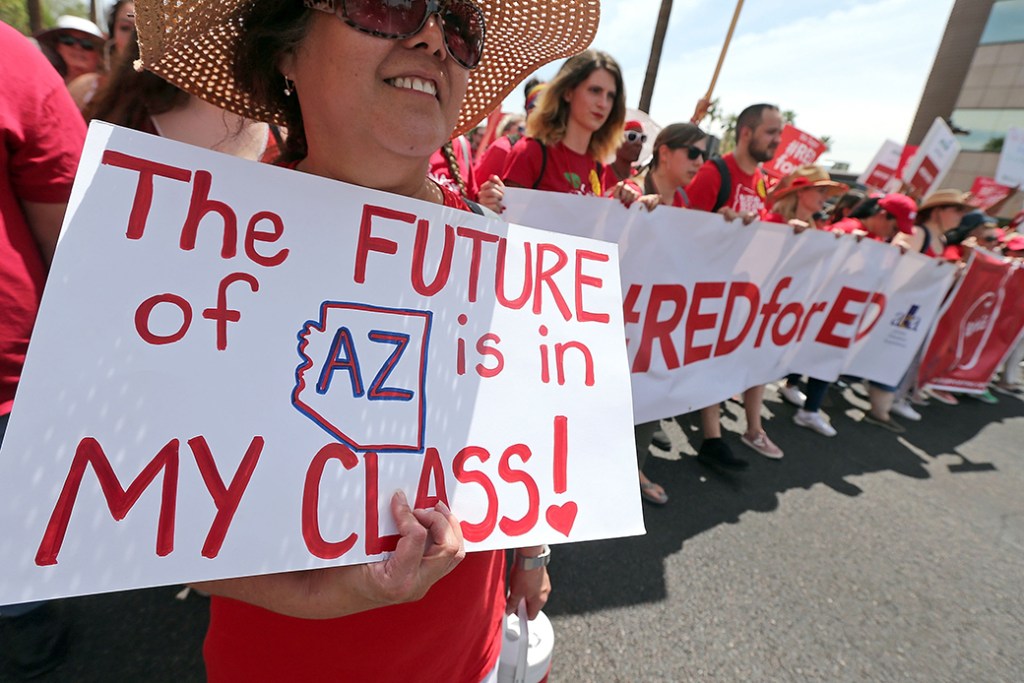
Too Little, Too Late for Many Gubernatorial Candidates on Education Funding
Some incumbent governors up for re-election this year are trying to convince voters that they will be champions for education—but their track records tell a very different story.
Media Contact
Government Affairs

After slashing their states’ education funding for years, some incumbent governors up for re-election in 2018 are trying to convince voters that they’ve seen the error of their ways by claiming that they will prioritize education going forward. But voters should be cautious about believing such promises.
Students, teachers, and families in many states are still feeling the aftereffects of the 2008 recession. While most states had to make significant cuts to K-12 education immediately after the 2008 recession, more than half of states across the country made education budget cuts so extreme that they still have not bounced back to 2008 funding levels. In some states, deliberate policy choices have prolonged and worsened the effects of the recession. For example, some governors gave tax cuts to wealthy residents and corporations rather than investing new revenue in students.
Earlier this year, teachers in a number of states, fed up with the predictable consequences of school funding cuts—decades-old textbooks, school buildings that leave kids sweltering or shivering, and salaries that have been stagnant for decades—walked out of their classrooms in protest. Teachers had reached “their boiling point.” It is telling that the general public and other education stakeholders supported teachers’ efforts; students, parents, and administrators also see the negative impact that drastic cuts to education can have on the quality of education.
Take the case of Arizona, where since 2008 public K-12 schools have faced the nation’s steepest cuts to state education funding: down 37 percent from 2008 levels. Part of the reason for these deep cuts is directly tied to state leaders’ insistence on cutting taxes no matter the harm to other priorities. Under Gov. Doug Ducey (R) and his immediate predecessor Gov. Jan Brewer (R), Arizona drastically slashed state corporate tax rates: In 2011, Brewer supported a $538 million phased-in corporate tax cut, and in 2015, Gov. Ducey signed a bill that was estimated to cut another $31 million in state revenue.
As a result of chronic disinvestment in Arizona’s schools, the state’s teacher salaries for the 2016-17 school year were 43rd in the nation, and per-pupil funding sat at 48th in the nation. Eventually, frustration with underfunding came to a head in a grassroots movement that culminated in a six-day teacher walkout in the state this spring.
Prior to the walkouts, Gov. Ducey had proposed a meager 1 percent teacher pay bonus for the year. Ducey received criticism when it was reported that he had given many members of his staff substantial bumps in pay, ranging from 5 percent to 100 percent, while letting teacher pay remain stagnant.
After the walkouts, Gov. Ducey eventually agreed to a substantial raise for teachers—20 percent by 2020—and additional funding for schools. But despite the walkout, Ducey has been reluctant to agree to proposals that would have provided adequate and realistic revenue sources for these changes, instead basing the viability of his hallmark “20 by 2020” campaign pledge on optimistic revenue projections, which of course put promised teacher raises at risk. Yet despite all of this, Ducey has been touting his education record on the campaign trail.
What’s more, Gov. Ducey supports voucher programs in the state that divert funding intended for public schools to private school vouchers. Although many of Arizona’s voucher programs precede his term, he oversaw a major expansion of vouchers in 2017, even though different news reports have found a lack of oversight and that the programs primarily benefited already affluent Arizonans.
Similar to Arizona, other states that experienced teacher walkouts this past spring, including Oklahoma and Kansas, have also prioritized tax cuts over investing in schools. In Kansas, the tax cuts were so disastrous that the Republican-controlled legislature eventually voted to overturn them with a veto-proof supermajority. Similarly, Oklahoma Gov. Mary Fallin (R) found herself advocating this year for a reversal of the tax breaks for oil and gas companies that she had previously championed.
In Wisconsin, incumbent Republican Gov. Scott Walker touts his record as “a pro-education governor.” Yet one of Walker’s first acts in office was to slash $426 million from school funding. Although he’s requested increases to education funding in more-recent years, state education budgets haven’t recovered: Per-pupil funding in Wisconsin remains 11 percent below what it was in 2008. What’s more, a Center for American Progress Action Fund analysis showed that his union-busting Act 10 legislation, signed into law in 2011, was associated with an 8 percent decline in teacher compensation and an increase in teachers leaving the profession.
These cuts to education funding matter for children. Adequate education funding is associated with improved academic achievement; higher likelihood of high school graduation; and increased lifetime earnings and intergenerational social mobility. School funding pays for the salaries that teachers need to make ends meet without taking on a second job, and it pays for important education programs such as literacy interventions and mental health services that students rely on to ensure they are realizing their potential. Positive outcomes associated with adequate educational funding are relevant not just for individuals but also for the communities and states in which they reside. Governors who choose to starve education in favor of giving tax cuts to the wealthy and corporations are selling their states’ futures short.
The sudden change of heart that some governors claim to have undergone in regard to investing in education is nothing more than a craven political ploy. As the old saying goes: Actions speak louder than words. Incumbents who have demonstrated in the past that education is not a priority should not be expected to govern differently if they are returned to office.
Lisette Partelow is the director of K-12 Strategic Initiatives at the Center for American Progress Action Fund. Jessica Yin is the special assistant for K-12 Education at the Action Fund.
The positions of American Progress, and our policy experts, are independent, and the findings and conclusions presented are those of American Progress alone. A full list of supporters is available here. American Progress would like to acknowledge the many generous supporters who make our work possible.
Authors

Jessica Yin
Former Policy Analyst

